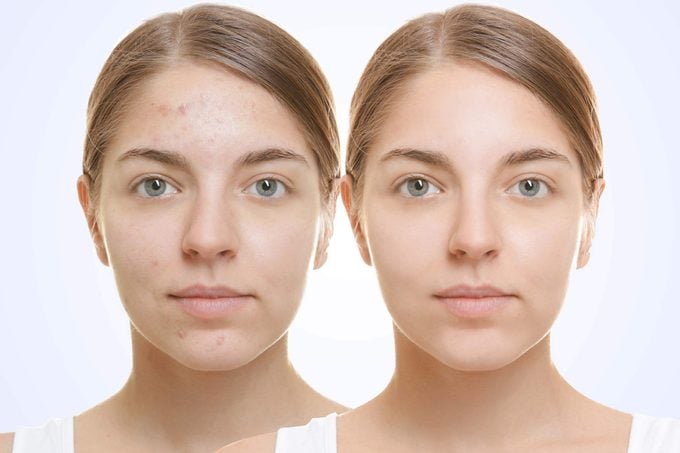9 Reasons Glycolic Acid Is the Miracle Your Skin Has Been Waiting For
Updated: Sep. 04, 2019
This gentle exfoliator is the holy grail of complexion perfectors.
Our editors and experts handpick every product we feature. We may earn a commission from your purchases.
 What is glycolic acid?
What is glycolic acid?
“Glycolic acid is an alpha hydroxy acid derived from sugar cane,” says Dhaval G. Bhanusali, MD, a dermatologist in New York City. What separates it from lactic and salicylic acids is its small molecular size that allows it to penetrate deeper into the skin to target your complexion concerns—whether it’s congested pores, blemishes, fine lines, uneven tone, or rough texture—and deliver more noticeable results. Here are nine reasons to make it a part of your skincare routine.
Glycolic acid makes skin glow
A variety of factors, such as aging and dryness, can slow down skin’s natural shedding process, leading to a dull, lackluster complexion. Glycolic acid-based exfoliants slough off dead skin cells, but not in the way you might expect. Unlike harsh scrubs, they work by gently dissolving the “glue” that makes old skin cells stick to the epidermis, revealing radiant, glowing skin, says Dr. Bhanusali. He recommends everyday exfoliation with a gentle cleanser, such as Glytone Mild Gel Cleanser or BeautyRx Balancing Glycolic Cleanser. And try these tricks for that natural glow.
Glycolic acid refines pores
Glycolic acid helps to unclog, refine, and diminish the appearance of enlarged pores by dissolving makeup, dirt, oil, and excess sebum. “After nightly cleansing, saturate a cotton pad with Mario Badescu Glycolic Acid Toner or SkinMedica Rejuvenative Toner,” says Debra Jaliman, MD, a dermatologist in New York City. If you’re on the go, she recommends a pre-soaked pad. Peter Thomas Roth Max Complexion Correction Pads has both glycolic and salicylic acids. And Bliss That’s Incredi-‘Peel’! Glycolic Resurfacing Pads are individually wrapped, so they’re easy to throw in your gym bag for after a workout.” And be sure to avoid these bad habits that can clog pores.
Glycolic acid fades discoloration
Dreaming of a more even-looking complexion? “Since glycolic acid sloughs off the top layer of the skin, it can help fade and even pigmentation, brown spots, and melasma,” explains Dr. Jaliman. Slather on a serum, like Drunk Elephant T.L.C. Framboos Glycolic Night Serum, which contains a cocktail of AHAs (glycolic, lactic, tartaric, citric, and salicylic), or Naturopathica AHA Refining Night Serum, and let it work its magic overnight.
Glycolic acid improves texture
Say goodbye to roughness. Glycolic acid is a skin-smoothing miracle worker. This chemical exfoliant revs up cellular turnover to resurface and retexturize skin, leaving it noticeably softer and smoother, says Dr. Jaliman. You already know the perks of regular exfoliation, but what about the pitfalls? Don’t miss the exfoliating mistakes that could do serious damage to your skin.
Glycolic acid treats acne
Glycolic acid is one of the ingredients should be part of your acne-fighting arsenal. Not only does it penetrate deep into the skin to address cystic and regular breakouts, but it helps increase cell turnover, accelerates healing, and fades acne scars. For all-over blemish control, try SkinCeuticals Blemish and Age Defense. To eliminate monster bumps, Dr. Jaliman suggests Murad Acne Control Spot Treatment. A wash like Glytone Exfoliating Body Wash or Donell AHA 20 Body Tingle can help eradicate body breakouts. Stay skin-smart by understanding the reasons for breakouts.
Glycolic acid combats the signs of aging
Want to turn back the clock on your complexion? There’s a reason glycolic acid is used in chemical peels and so many anti-aging topicals. Most notably, it stimulates the production of collagen and elastin, the keys to firm, youthful skin. Dr. Bhanusali suggests using in an at-home glycolic acid peel, like Dennis Gross Skincare Alpha Beta Medi–Spa Peel, to improve tone, renew skin, and fight fine lines on a weekly basis. Keep in mind that these retinol-like results come with similar side effects, including increased photosensitivity, so it’s imperative to wear sunscreen every day.
Glycolic acid helps keratosis pilaris
“Glycolic acid is also excellent for keratosis pilaris, often referred to as chicken skin, those pesky, itchy bumps often found on the backs of arms,” says Dr. Jaliman. Instead of using an abrasive scrub, try applying a glycolic acid lotion, such as Alpha Skincare Revitalizing Body Lotion or Neostrata High Potency Cream, before bedtime. This will help unclog pores and dissolve dry skin without irritation. Read up on eight foolproof ways to finally get rid of chicken skin.
Glycolic acid prevents ingrown hairs
Ingrown hairs—those painful red bumps that pop up in the facial, armpit, and bikini area—occur when a strand curls back down into the skin instead of growing out, according to the Mayo Clinic. Popping the bump or poking and prodding with a tweezer raise the risk of infection; a better idea is to apply a warm compress and wait for it to heal on its own. But the best way to banish bumps is to prevent them in the first place. And for that, glycolic acid is a total game-changer, exfoliating away dead skin cells and thwarting the formation of future ingrown hairs. Dr. Jaliman’s picks (Completely Bare Bikini Bump Blaster Pads and Bliss Ingrown Eliminating Pads) are also infused with witch hazel to soothe redness and inflammation.
Glycolic acid can be used by everyone
One of the best things about glycolic acid—other than its many benefits—is that everyone can use it, regardless of age, skin type (even sensitive complexions), and tone. Plus, it’s safe to use during pregnancy and while breastfeeding, according to Heidi Waldorf, MD, director of cosmetic and laser dermatology at Mount Sinai School of Medicine and founder of Waldorf Dermatology & Aesthetics in New York City.
